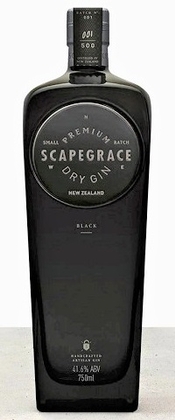“Hello Darkness My Old Friend. This is the taste of Black Velvet profile. Unique. Complex. Unexpected.” So reads the introductory note attached to the bottle of Scapegrace Black Gin.  And it is all true—see for yourself with your first encounter with Scapegrace. The gin you’ve just poured into your glass is indeed black. The initial sip is smooth, fresh, and fruity, with cherry, peach, pineapple, red and blue berries and apple flavors, plus juniper, cloves, cinnamon and other savory spices. Rather than dominating the overall taste, that spice adds subtle depth and texture. You will also find immensely appealing floral notes here, with everything enveloped in a soft and silky texture. And unlike too many fancy gins this one is very recognizably gin—not some over-the-top perfumy collection of random scents.
And it is all true—see for yourself with your first encounter with Scapegrace. The gin you’ve just poured into your glass is indeed black. The initial sip is smooth, fresh, and fruity, with cherry, peach, pineapple, red and blue berries and apple flavors, plus juniper, cloves, cinnamon and other savory spices. Rather than dominating the overall taste, that spice adds subtle depth and texture. You will also find immensely appealing floral notes here, with everything enveloped in a soft and silky texture. And unlike too many fancy gins this one is very recognizably gin—not some over-the-top perfumy collection of random scents.
Rather than savoring gin straight up, my own cocktail preference these days is—what to call it? Perhaps a restrained gin & tonic that focuses more on gin than on tonic. I add an ice cube and a sparse couple of inches of tonic to about two or three inches of gin. One reason I don’t add too much tonic is that I am generally turned off by the unpleasant sweetness in most American tonic water thanks to the presence of high fructose syrup in it, which I find unpleasant as well as unhealthy (compare, for example, Schweppes tonic in the USA versus the more savory Schweppes you get in Europe and you’ll see what I mean.)
But I digress. Let’s return to what is probably the most obvious question one asks about Scapegrace gin: what makes it black? The answer is berries, specifically Aronia berries. A plant native to North America and a member of the Rosaceae family, Aronia (also known as “chokecherry”) can now be found growing across the world, primarily in wet woodlands and swamps. From a horticulturist’s point of view, Aronia’s natural advantages include its resistance to drought, pests and disease. From a cocktail lover’s perspective, in addition to being wonderfully tasty, the gin seems like a bit of magic in the way it shifts from black to gray to rosy pink with the addition of tonic, or even just ice.
In various cultures Aronia berries have long been used in pies, muffins and juices. Recent studies have found that Aronia berries may have anti-cancer properties and other health benefits. They are also relatively high in vitamins and minerals. There does not appear to be any well-documented evidence of specific risks or hazards related to the consumption of Aronia although it’s always possible that some people may be allergic to it.
Aronia berries have long been used in places as diverse as Minnesota and Lithuania to make wine! I have never seen or tasted these wines myself, so I don’t know if it is black. But as I look out my window, I see that the sun seems to be setting. Perhaps it’s time to pour myself a black gin and tonic while I contemplate this issue further.
Scapegrace Black Gin, New Zealand Distilling Company. Importer: 375 Park Avenue Spirits, Louisville KY
7
